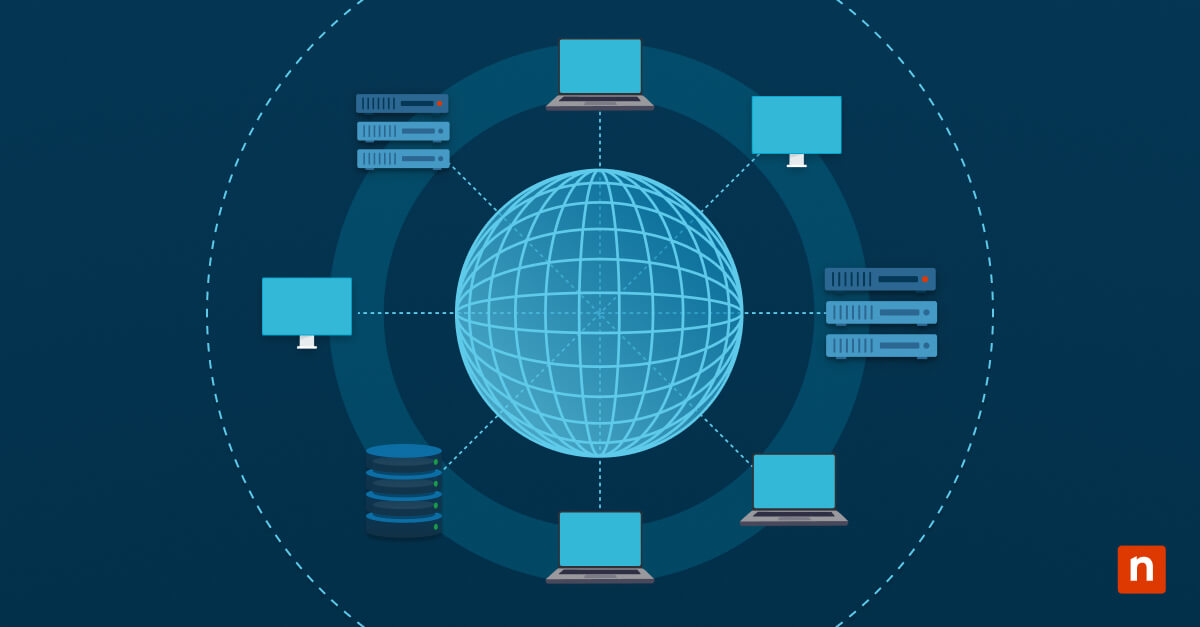Key Points
- Unified Endpoint Management (UEM) is a centralized solution that integrates Mobile Device Management (MDM) and Enterprise Mobility Management (EMM) to monitor, manage, and secure all endpoints from a single dashboard.
- UEM simplifies IT operations by providing real-time visibility, policy enforcement, and endpoint security across desktops, laptops, smartphones, tablets, IoT devices, and virtual machines.
- Core UEM components include device management, cross-platform OS support, automated provisioning and enrollment. BYOD and app privacy controls, mobile app and identity access management, and endpoint and data security.
- UEM improves IT efficiency and end-user experience by automating tasks like patch management, remote device wipe, and VPN configuration.
- Organizations benefit from UEM by reducing compliance risks, protecting data, supporting hybrid work, and collecting actionable device insights for strategic IT decisions.
Unified endpoint management (UEM) is software that monitors, manages, and secures desktop computers, laptops, and mobile devices in a single pane of glass. It is a comprehensive approach to the modern workforce, integrating mobile device management (MDM) and enterprise mobility management (EMM) in a centralized dashboard.
The most obvious benefits of using UEM are operational efficiency and improved data governance. Because your IT team has complete visibility into your entire fleet (including smartphones and tablets), they have a better understanding of their IT estate and can now proactively and pre-emptively create policies to reduce security vulnerabilities. For a practical overview of how to build and implement such a strategy, check out our Unified Endpoint Management Strategy video guide.
The advantages of UEM are such that experts predict its market to register a CAGR of over 18.6% between 2024 and 2032 (Global Market Insights) and be valued at $23.6B by 2033 (Custom Market Insights).
Download our eBook to learn how to choose the right UEM solution for your business needs.
The history of UEM
UEM, sometimes referred to as a complete endpoint manager or comprehensive endpoint manager, evolved from MDM tools that allowed IT administrators to monitor and manage their company’s mobile fleets. MDM enabled them to perform a variety of actions on smartphones and tablets, whether that was provisioning them with new software or installing enterprise apps.
However, business leaders quickly realized that despite the power and the countless reasons they need MDM, it could not adequately support the modern workplace, which is often comprised of both mobile devices and traditional endpoint devices.
Expert tip: Interested in learning the best MDM solutions of 2025? Check out our thorough IT guide.
The differences between MDM, MAM, EMM, and UEM
Mobile device management (MDM)
Mobile device management (MDM) software allows IT teams to monitor and manage mobile and remote devices, including phones, tablets, laptops, and even desktop computers, for remote workers. MDM lets administrators have a certain degree of control over endpoints, such as the ability to lock or wipe the device if it is lost or stolen, making it an ideal option for companies with a bring your own device (BYOD) policy.
Expert tip: Curious whether you need an RMM or MDM? Read through our guide on RMM vs MDM.
Mobile application management (MAM)
As more companies began implementing bring your own devices (BYOD) policies, employees began to worry that their personal phones and data would be easily accessible by their IT department. Rather than purchasing another device solely for work, a new solution, MAM, was born.
Mobile application management allows employees to use their personal mobile devices for work while keeping their sensitive data safe. With MAM, IT personnel can monitor and manage corporate apps and the data inside them without seeing any personal data.
Expert tip: We wrote a more in-depth comparison guide between MDM and MAM here.
Enterprise mobility management (EMM)
Still, MAM solutions were overwhelmed by the rapid growth of new apps for iOS and Android devices. Enterprise mobile management tools were then developed to secure corporate data on employees’ mobile devices while also providing a wide range of IT systems to meet companies’ ever-evolving needs. This included monitoring, managing, and securing all devices in an IT network.
Expert tip: NinjaOne offers a streamlined, intuitive EMM solution to ensure sensitive data stays protected—always.
Complete endpoint manager
UEM software emerged to address any limitations in EMM, such as enabling the management of on-site end-user devices. It combined the functions of EMM with other much-needed features so that IT administrators could manage on-premises end-user devices and BYOD. UEM tools were also created to integrate with many endpoint security tools and applications to help companies become more efficient.
Expert tip: There is no “better” solution among MDM, EMM, and UEM. Always choose the platform that best suits your needs and IT budget.
7 UEM components
All comprehensive endpoint management solutions have these seven components.
Device management
The main component of a complete endpoint manager is device management. As its name suggests, it describes how your IT team maintains endpoint devices, including virtual machines and IoT devices. Some tasks of device management include:
- Encryption policies
- Configuring VPN and Wi-Fi
- Geotagging
- Remote locking and wiping
- Setting password policies
OS support
Because comprehensive endpoint management needs to support multiple devices, it’s vital that it can support different operating systems, from iOS to Android to Windows to Mac.
This is a major deciding factor when choosing the right UEM platform for your business. While most vendors offer the same functionalities, some differ in the type of device they can manage. We discuss this in more depth in our discussion of the 10 best endpoint management software in 2025.
Deployment, enrollment, and provisioning
Ideally, your complete endpoint manager should offer an efficient and convenient way of deploying, enrolling, and provisioning devices. For example, NinjaOne helps you easily automate new device setup or install a NinjaOne agent using zero-touch provisioning.
BYOD and privacy
Great UEM tools limit administrator roles, so IT teams can’t treat personal devices as corporate ones. This is crucial: Your team members must feel safe that personal data in their BYOD is kept safe from prying eyes. As such, comprehensive endpoint managers can only access corporate apps and any data inside them.
Mobile app management
As mentioned previously, complete endpoint managers have MDM tools built inside them so you can manage and monitor your entire fleet. Your UEM software vendor must provide most, if not all, of the MDM features in their tool, in addition to other functionalities. (We’ve written another guide on the 6 features you need in your MDM solution here.)
Identity and access management (IAM)
UEM and IAM typically go hand-in-hand, and for good reason. Identity and access management allows your IT department to determine what users can and cannot access. This ensures that sensitive data and corresponding functions are restricted to the right people. A complete endpoint manager distributes authentication certificates to guarantee that only devices enrolled in the platform can access enterprise apps.
Security
It goes without saying that all comprehensive endpoint managers need robust mobile security and other security protocols. Just like any software, UEM can be exploited by threat actors and infected with ransomware or other types of malware if it is not maintained correctly. Choose a vendor that offers extensive (and preferably automated) patch management and similar tools in its governance plan and endpoint security.

5 advantages of a complete endpoint manager
1) Improves user experience
With a UEM solution in place, users can focus on their work instead of managing or protecting their devices. It ensures that users have a more flexible, secure, and hassle-free experience when using remote devices.
2) Protects endpoints & data
One of UEM’s main purpose is to protect endpoints and data from threats. From patching vulnerabilities to updating applications, unified endpoint management offers multiple ways to automate endpoint security, reducing the need for manual intervention.
3) Reduces compliance issues
As compliance standards change, UEM helps ensure that all your devices remain up-to-date and in compliance with regulations. This reduces any compliance issues that could negatively affect the IT team and the entire organization.
4) Supports bring your own device (BYOD)
Bring your own device (BYOD), is a policy that allows employees to use their own devices for work-related tasks. These devices can be tricky to manage and secure, but with UEM, organizations can support this policy and allow employees to use their own devices if necessary.
5) Provides valuable info
Unified endpoint management collects valuable data about endpoints that can be used for business decisions. Additionally, this information can be used to identify areas for improvement and set goals to improve the IT team and its performance.
The growing need for comprehensive endpoint management
UEM is arguably the future of hybrid work. We saw remote and hybrid work increase dramatically in 2020, but fast forward to today, and experts predict that more and more companies will be working with a hybrid arrangement in the coming years.
In fact, new Gallup research suggests that nine out of 10 remote-capable employees prefer some level of remote work flexibility, with six in 10 specifically preferring hybrid work. It’s no wonder, then, why Zippia’s remote workforce research shows that 36.2 million American employees will be working remotely by 2025.
As remote and hybrid workforces continue to grow in popularity, organizations need an efficient way to monitor, manage, and secure all the endpoints that team members use. That’s where unified endpoint management comes into play. With a UEM solution, organizations can manage and protect their endpoints easily from a single console.
Expert tip: When choosing the right UEM tool for your business, consider reading this unified endpoint management strategy complete guide.
What to look for in a UEM solution
Because every IT team faces different challenges, it’s tough to find a one-size-fits-all UEM solution for an organization. However, as you search for your UEM software, keep in mind that there are standard unified endpoint management criteria that every worthwhile solution will meet, such as:
Security
The unified endpoint management solution you choose should provide top-notch endpoint security to protect confidential information. Additionally, a UEM solution should safeguard endpoints and data even when employees choose to work remotely on various networks.
Access
Access management allows team members to control user and device access to ensure that information doesn’t fall into the wrong hands. UEM software uses many security policies and methods to help you manage remote access, such as encryption, password requirements, and multi-factor authentication systems.
Compatibility
Compatibility is an important factor to consider when adding a new UEM solution to your IT environment. You’ll want to ensure that the software you choose is compatible with your other systems and runs smoothly without creating any issues.
Ease of use
One of the main reasons why organizations adopt UEM is to reduce management complexity. A UEM system must be intuitive and easy for team members to access and use.
Boost IT visibility and efficiency instantly. Watch a comprehensive guide to unified endpoint management.
Centralize your endpoint management with NinjaOne
If you’re looking for a comprehensive endpoint manager that centralizes processes, offers multi-platform management, and is built for remote or hybrid workforces, look no further than NinjaOne.
This efficient, all-in-one endpoint management solution also offers network monitoring and management, OS and third-party application patch management, endpoint monitoring and alerting, and much more.
When you’re ready, request a free quote, sign up for a 14-day free trial, or watch a demo.










